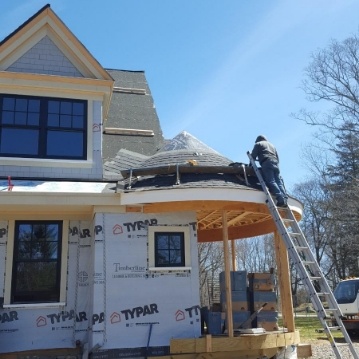Your roof is easily one of the most important features on your Boston, MA home. After all, it protects everything that lies beneath it. Taking good care of this structure is key for preserving your foundation, siding, drywall, flooring, and more. Knowing when to replace your roof can help you avoid wasting money on repairs that won’t provide the lasting results you need. The following are six signs that your roof has reached the end of its lifespan.
1. Everyone Else in Your Neighborhood Is Reroofing Their Homes
If you’ve recently purchased an existing-construction home and have noticed that all of your neighbors are reroofing their homes, it’s probably time to schedule your own roof replacement as well. Depending upon the materials they’re made of and the overall quality of their construction, most roofs last between 25 and 50 years.
In the average residential development, many homes have the same roofing styles and materials, and they were built by the same roofing companies at the same time. When the houses around yours have roofs that age out, you can safely assume that your own roof is at or near the end of its lifespan.
2. Shingle Granules Are Falling Off
After heavy rain passes, take a good look at the base of your downspouts. If there are shingle granules in your gutters or just below your downspouts, this is a good indication that your shingles are wearing out.
In asphalt shingle roofs, shingle granules keep the underlying fiberglass mat and asphalt protected from the natural elements. They’re your roof’s first defense against the sun’s harmful UV rays, wind, rain, sleet, and snow. Once they’re gone, your roof will have a higher likelihood of developing leaks, mold problems, and pest infestations.
Dark spots are another common sign of shingle granule loss. If you spot dark spots on your roof when viewing it from the curb, these darker areas are probably spaces where shingles have already shed their granules. However, dark spots or streaks can also be the result of fast-growing algae, mold, or moss. In each of these instances, what you’re seeing is an age-related decline in both your roof’s functionality and its aesthetics.
3. Shingles Are Bowed, Curling, or Cracked
Curled, cracked, or bowed shingles aren’t possible to repair. Although you can replace a single damaged or missing shingle, these structural changes are usually widespread and age-related. When roofs are no longer seamless, watertight surfaces, the buildings they cover are unprotected.
4. Your Roof Is Spongy and Soft
Walking on your roof isn’t recommended. However, if your roofer happens to traverse this surface and determines that it’s spongy and soft, you may be advised to replace it. Soft, springy roofs are a sign of water damage at the roof’s underlayment and framing.
Changes over time in how roofs feel underfoot normally mean that there’s soft, rotten wood supporting them. This may be the case if your home has had an ongoing leak that was left unchecked for months or even years. Even if you don’t have discolored or blistered paint, water spots on your ceiling, or significant drywall or siding damage, your roof may have a slow, hidden leak that’s been unnoticed for quite a while.
5. Separation at the Roof Valleys and Protrusions
Most homes have several sections of roofing that join together. These intersections are known as valleys. They’re aesthetically pleasing and often essential for complementing and finishing home designs. They’re also high-risk areas for leaks and other problems. When roof valleys begin to pull apart and create viable points of ingress for rainwater and other moisture, entire roofing systems are ready for replacement. Repairing separation at roof valleys will only delay the inevitable.
This is also true of separation that occurs around your roof’s protruding elements. Features like skylights and chimneys should be watertight and perfectly sealed. If you have a leaking skylight or water damage around an exhaust pipe or chimney, the only sure way to protect your home from continued moisture problems is by having your aging roof replaced.
6. Your Roof Is Sagging
Sagging is a problem that can affect roofs at all stages of aging, particularly when roofing systems are poorly designed or poorly built. This issue could be an indication of substandard bracing, undersized trusses or rafters, or roofing materials that are simply too heavy.
At Aspen Roofing Services, we offer winter roofing support, historical roofing, custom sheet metal, and residential roof installation, maintenance, and roofing repair services. We proudly serve residents of Boston, MA and the surrounding communities. To find out more about replacing your roof or to schedule an appointment, contact Aspen Roofing Services now.


